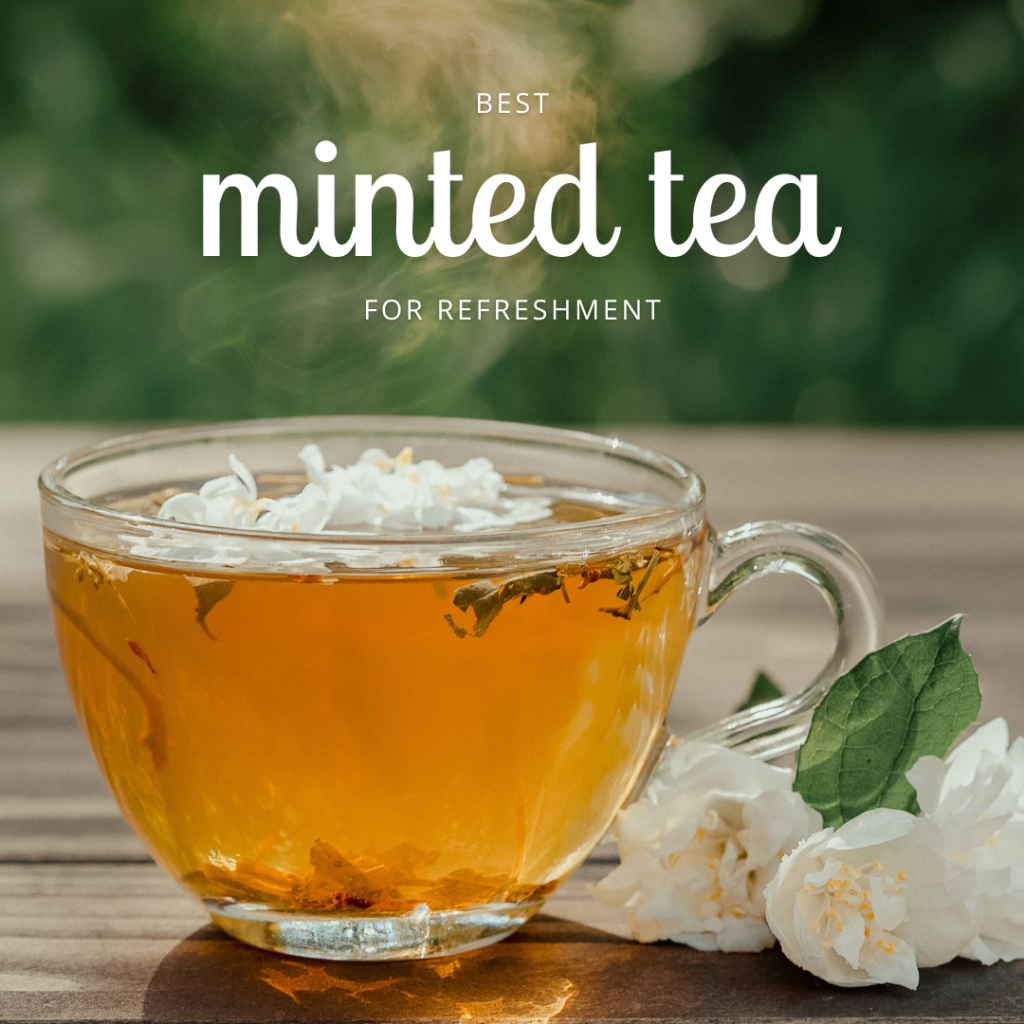
Table of Contents
A Refreshing Journey Through Flavor, Culture, and Wellness
Minted tea, a delightful infusion of mint leaves in hot water, has been cherished across cultures for centuries. Known for its invigorating aroma and countless health benefits, this herbal beverage transcends borders, offering both comfort and beneficial properties. In this comprehensive guide, we’ll explore the rich history, cultural significance, health advantages, training methods, and more. Whether you’re a tea supporter or a health-conscious individual, tea promises a flavorful path to better living.

1. The Origins and Cultural Significance of Minted Tea
Minted tea’s roots trace back to antique civilizations. In Morocco, it is an integral part of daily life, representing hospitality and tradition. Moroccan tea, or Maghrebi mint tea, combines green tea with fresh spearmint leaves and sugar, served in ornate glasses during social meetings. This ritual is not just about taste; it’s a signal of welcome and friendship.
In Senegal, the tea ceremony known as attaya involves a three-step brewing procedure, emphasizing patience and community bonding. Each serving varies in strength and sweetness, reflecting the deep cultural ties associated with tea serving. Similarly, minted tea is a staple in Middle Eastern and North African homes, where it fosters linking and conversation.
Mint has also been historically important in Ancient Egypt, Greece, and Rome. Egyptians used mint in burial rituals and medical practices. The Greeks and Romans revered it for its digestive properties and used it to flavor pulps and wine.
2. Types of Mint Used in Minted Tea
There are several selections of mint used in minted tea, each offering a distinct flavor and set of benefits:
- Peppermint (Mentha × piperita): Known for its high menthol content, peppermint delivers a bold, cooling impression. It’s particularly effective in relieving problems and digestive issues.
- Spearmint (Mentha spicata): With a sweeter and more delicate flavor, spearmint is favored in culinary and medical uses. It’s less intense than peppermint, making it ideal for daily ingesting.
- Apple Mint (Mentha suaveolens): This variety offers a subtle apple-like aroma, perfect for those who enjoy mild herbal drinks.
- Chocolate Mint: As the name suggests, this mint has a slight chocolatey undertone, adding a exclusive twist to the classic minted tea.
Each type of mint brings its own aroma, flavor, and health benefits, allowing for versatile uses and modified blends.
3. Health Benefits of Minted Tea
Tea is more than just a tasty drink. It’s a capital of wellness. Here are some famous health benefits:
3.1 Digestive Aid
Tea helps relax the digestive tract, making it effective for relieving indigestion, gas, and swelling. It stimulates bile flow and supports the gastral enzymes that break down fats.
3.2 Respiratory Relief
Menthol, the key compound in mint, acts as a ordinary decongestant. It can clear sinuses, ease throat irritation, and improve breathing, especially during colds or dislikes.
3.3 Stress and Anxiety Reduction
Mint contains compounds that may interact with GABA receptors in the brain, helping a sense of calm. The simple act of drinking warm tea also has meditative potentials, reducing cortisol levels.
3.4 Antioxidant Properties
Tea is rich in the flavonoids and polyphenols. These antioxidants fight free radicals, dropping oxidative stress and inflammation. This helps in lowering the risk of chronic situations such as heart disease.
3.5 Menstrual Pain Relief
Some studies suggest that peppermint tea can act as a muscle relaxant, helping to alleviate menstrual cramps and embarrassment.
3.6 Oral Health
The antibacterial properties of mint help freshen breath and kill damaging bacteria in the mouth, promoting oral hygiene.
3.7 Boosting Immunity
Mint leaves contain trace vitamins and minerals such as vitamin C and iron that care immune function.
WebMD: Mint Tea Health Benefits
Healthline: Spearmint Tea Benefits
Vogue: The 7 Health Benefits Of Mint Tea
4. Nutritional Profile of Minted Tea
While tea is not calorie-dense, it provides critical nutrients in trace amounts:
- Calories: Virtually zero, unless sweetened.
- Vitamins: Contains small amounts of Vitamin A and C.
- Minerals: Offers potassium, calcium, and magnesium.
- Phytonutrients: Rich in rosmarinic acid, luteolin, and menthol, which donate to its therapeutic properties.
Unlike sugary sodas or processed drinks, minted tea is hydrating and health-boosting without adding further calories.
5. How to Make the Perfect Minted Tea
Creating a tasty cup of minted tea is both simple and rewarding.
Ingredients:
- A handful of fresh mint leaves (or 1-2 tsp dried mint)
- 2 cups of pure water
- Optional: Green tea, sugar, lemon, or honey add
Instructions:
- Boil Water: Bring water to a rolling boil in teapot.
- Prepare Mint: Rinse the mint leaves carefully.
- Steep: Add the leaves to a teapot or cup and pour in the hot water. Let it steep for 5-10 minutes.
- Flavor (Optional): Add lemon slices, honey, or sugar to enhance the taste of mint tea.
- Serve: Strain into a cup and enjoy the mint tea.
The Mediterranean Dish: Arabic Tea Formula with Fresh Mint
6. Variations and Creative Uses
Minted tea is incredibly multipurpose. Here are some creative ways to love it:
- Iced Mint Tea: Brew mint tea and chill it with ice cubes. Add slices of cucumber or berries for a refreshing twist.
- Mint and Lemon Detox Tea: Combine mint with lemon and ginger for a detoxifying drink.
- Minted Tea Smoothie Base: Use cooled minted tea as a liquid base in charmers.
- Culinary Uses: Add minted tea as an ingredient in desserts like sorbets or mint-infused syrups.
- Cocktail Mixer: Use chilled minted tea in mocktails and cocktails for a unique herbal kick.
7. Minted Tea Around the World
Morocco
The tea ceremony is an art form. It involves pouring the tea from a height to create foam, representing prosperity.
USA
Minted tea is often blended with excitements like cardamom, cloves, and ginger to create a refreshing chai variant.
Middle East
Mint is commonly paired with black tea, sweetened heavily, and served after meals.
Western Countries:
The wellness movement has popularized herbal infusions like minted tea, often marketed as detox or stress-relief beverages.
Wikipedia: Senegalese Tea Culture
8. When to Drink Minted Tea
Tea is suitable for various times of the day:
- Morning: For a caffeine-free energy boost.
- After Meals: To aid digestion.
- Evening: As a calming bedtime ritual.
- During Illness: To soothe symptoms of colds, coughs, or indigestion.
You can even incorporate it into your daily routine by replacing sugary drinks or caffeinated beverages.
9. Precautions and Side Effects
Although generally safe, some individuals should be cautious:
- GERD: Mint can relax the esophageal sphincter, worsening reflux.
- Pregnancy: High doses of peppermint may not be advisable.
- Medication Interactions: Consult your doctor if you’re on blood pressure or diabetic medications.
Moderation is key, as with any herbal remedy.
10. Conclusion
Tea is a timeless beverage that bridges tradition, flavor, and health. Its wide range of benefits, cultural richness, and culinary flexibility make it a staple in households worldwide. From Moroccan tea ceremonies to your morning wellness routine, minted tea is a testament to nature’s ability to heal and comfort. By making it a part of your lifestyle, you’re not only enjoying a flavorful drink but also embracing centuries of wisdom.
Let every sip of minted tea be a reminder of simplicity, purity, and wellness.
External Resources Recap:
- WebMD: Mint Tea Health Benefits
- Healthline: Spearmint Tea Benefits
- Vogue: The 7 Health Benefits Of Mint Tea
- The Mediterranean Dish: Arabic Tea Recipe with Fresh Mint
- Wikipedia: Senegalese Tea Culture
also read
Discover the Secrets of Perfect Minted TeaWhat Are the Benefits of Using Non Toxic Candles?
5 Best Substitutes for Coconut Oil You Should Try
Elevate Your Dishes with Yellow Peppers
Discover the Flavor: Beef Pepperoni Unveiled
Unlock Silky Hair with Keratin Shampoo Solutions
Best Transform Your Space with Roomy Spray Today!
Best Discover the Power of Pure Ribose Cream for Radiant Skin



